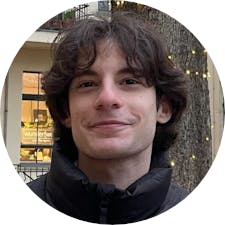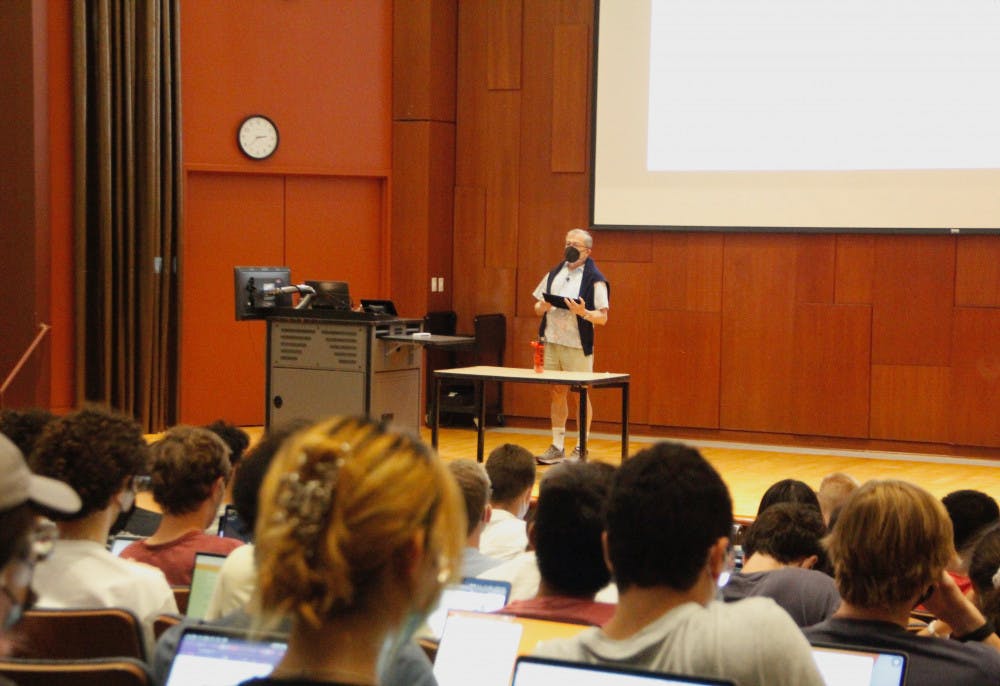“I’m so happy to be standing up here before you and not delivering this lecture from home,” said James Kellner, associate professor of ecology, evolution, and organismal biology, to his class on Wednesday morning.
More than 200 students in a Salomon Center lecture hall suddenly erupted into a wave of applause, a moment of shared gratitude between Kellner and his students.
University classes officially began Sept. 8 for the fall term, the majority of them in person with a few online and hybrid classes.
Like many other faculty, Kellner has found himself lecturing to an in-person class for the first time since the pandemic first began impacting classes in spring 2020.
“If you had asked me before the semester what was one word that described how I felt about the beginning of the semester, it would be optimistic,” Kellner told The Herald.
Other faculty members echoed this sentiment.
“I was very glad to be going back in person,” Ross Cheit, professor of political science, said. “I was certainly delighted to be in the same room.”
Looming beneath the feeling of overwhelming excitement, however, is a sense of hesitancy and nervous anticipation.
“There was some nervousness about the dynamics of the classroom, a concern about the different ways we’ll communicate because of the masks,” Cheit said. “It’s still unclear to me how well I can monitor my student’s reactions without the proper facial cues. … Do they look confused? Are they disagreeing? … I think we might want to adopt some hand signals.”
Both Kellner and Anthony Cheung, associate professor of music, expressed some concern about shopping period logistics and room capacity.
Due to possible overcrowding, Cheung held his first lecture over Zoom, “which felt oddly familiar.” Kellner reached out to the University to help “efficiently move large volumes of people in and out of” the Salomon Center’s large lecture space in order to mitigate potential virus spread.
For Connie Crawford, adjunct lecturer in theater arts and performance studies, the first week of in-person classes has led to increased student engagement.
“People are excited, but they’re also anxious. There’s a lot of free-floating energy,” Crawford said. “But students really want to be live and interactive.”
Many professors are finding that in-person classes have allowed students to feel a better sense of community.
“It’s nice to teach in person, I think the students appreciate seeing what you’re talking about instead of just watching it,” Eric Chason, professor of engineering, said. “Having other students around is very important. … Students feel good they're doing this with someone else instead of by themselves.”
“There’s an energy in the fact that we’re together,” Cheit said. “It was so nice to be together again, everybody’s been wanting it.”
For Cheung, who started teaching at the University last year, returning to the classroom has allowed him to experience Brown as a whole, rather than just the “remote and displaced” culture of the pandemic.
“In one of my classes, singing is an important component and that was never possible in a meaningful way on Zoom,” Cheung said. “Being able to do activities like that, to make meaningful connections in person, will just be so satisfying.”
Faculty members voiced concern over the possibility of faculty burnout as they approach their third consecutive semester after the 2020-2021 school year.
“I think many faculty feel that the summer was not as restorative as it might have been, and last year was really draining,” Cheit said. “Uncertainty is draining, … and the faculty are not alone in the boat. But in a normal year, students don’t have to wonder if their faculty members are burned out, and I think a lot of people are near the end of their rope.”
Crawford emphasized the facilities staff and their non-stop work.
“They’ve got to be exhausted, they’re doing triple the cleaning!” Crawford said. “Everybody’s tired — students, faculty, staff, facilities — but everybody’s doing the best they can. Students have been especially conscientious, going above and beyond the University’s protocols to make the transition process smoother.”
Despite fears of burnout, some professors have found solace in the University community with the return of in-person operations.
Cheit cited a “really good feeling” in seeing new faces at the first faculty meeting of the year that was held in person after a year and a half of only online meetings.
Chason, who lost his daughter in the 2009 H1N1 pandemic, was initially worried over how the University would respond to the ever-changing status of the pandemic. “I was very gratified and emotional (that) Brown responded so properly to the pandemic. They didn’t just ignore it because students were not getting sick,” Chason said. “I was really glad about that.”
While the rest of the semester remains shrouded in uncertainty, faculty members are making sure to stay flexible in case the University returns to remote learning in the future.
“The school leadership has been transparent and communicative about updates and procedures, and there’s a commitment to safety and science,” Cheung said. “I do worry, of course, and have hybrid plans in place should we need to make changes.”
Cheit echoed Cheung’s emphasis on adaptability.
“I just think the key is to understand that this year is gonna be somewhat different,” Cheit said. “And we need to be flexible to get through it.”

Alex Nadirashvili was the managing editor of multimedia and social media for The Brown Daily Herald's 133rd Editorial Board. As a former University News editor, he covered faculty, higher education and student life, though his proudest legacy is The Brown Daily Herald TikTok account.





